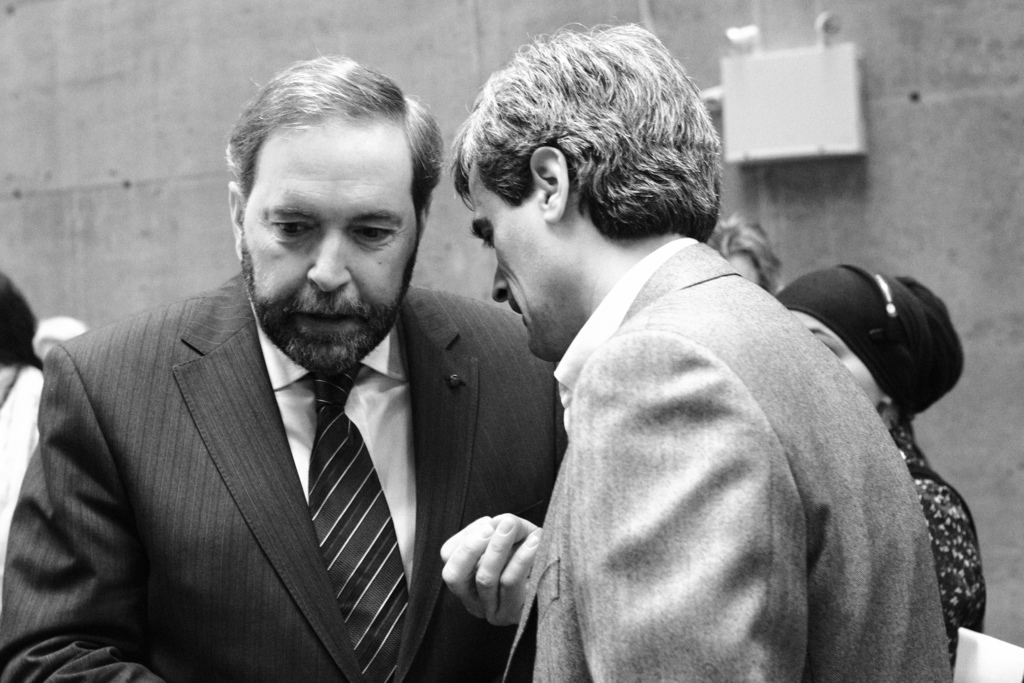Spoiler alert: Political pundits are like Hollywood wiseguys trying to figure out what films will be box office hits. In the memorable maxim of screenwriter William Goldman (Butch Cassidy and the Sundance Kid, All the President’s Men), “nobody knows anything.” You should know this truth applies in spades in the political world as well. With that humbling confession out of the way, we can examine the forthcoming election boldly and with confidence.
Wise commentators begin with a little historical background. So: Before the NDP there was the Co-operative Commonwealth Federation (CCF). It was formally launched in 1933. Exactly a decade later, on a balmy day in September 1943, a Gallup Poll showed the young upstart party at 29 per cent, the Liberals and Tories with 28 per cent each. As the party paper put it somewhat prematurely, “CCF SWING SWEEPS CANADA.” Of course a poll can only be empirically tested in an actual election, and in 1945 the CCF ended up in third place with 16 per cent of the total vote.
Time and elections went by. The CCF could sweep nothing beyond Saskatchewan. Accordingly, in 1961 it was unceremoniously buried and a modernized iteration called the New Democratic Party was created. More time and elections came and went, and the new party retained its undisputed hold on third place. But on a sweet spring day in May 1987, under the popular Ed Broadbent, the NDP made history again — at least in polling terms. It stood at 37 per cent, the Liberals at 36 per cent, the PCs 25 per cent. A year and a half later, in the election of 1988, Brian Mulroney’s PCs raced home with 43 per cent, the Liberals were second with 32 per cent , and the NDP brought up its traditional rear with a fraction over 20 per cent. That was the CCF/NDP’s best showing in its half-a-century history.
Again time passed and again Canadians passed on the NDP. The New Democratic Party was no longer New. It wasn’t even always third. Sometimes it ended up a bleak fourth behind the Bloc Quebecois or the Reform Party. At party rallies, the leader, whoever it was, continued to be introduced as “the next prime minister of Canada.” These were the dog days.
Jack Layton became leader. His fourth campaign was in 2011. With three weeks to election day, the NDP remained mired in 18-per-cent territory. Of course as we all now know, le miracle du Quebec intervened. Layton became le bon Jack and the NDP became Official Opposition for the first time ever with 30.6 per cent of the vote. Merci mille fois, Quebec.
Jack’s monumental contribution was to pull the plug on a rather pesky 78-year pattern. But then he left us, far too soon. What next? Was Jack our Moses, taking us to the edge of that promised land he himself would never enter? Tom Mulcair was a promising replacement, but the fickle finger of fate again intervened. Justin Trudeau took over the Liberals and, according to the polls, second place, even first place. The NDP’s only too-familiar 18-20 per cent territory returned with a vengeance.
Despite Mr. Mulcair’s impressive performance, glowingly described by the entire mainstream media, the yardsticks refused to move — until suddenly, in the last several weeks, they did. Alberta created the climate. Mr. Trudeau’s rookie mistakes caught up with him. Mr. Harper continued to be Mr. Harper, which seems to have caught up with him too. And after all those months with little public appreciation, Mr. Mulcair began to catch on.
And so today we have, trumpets please, a deadlock — a three-way tie, with the Libs way down from last year, the Conservatives way down from their triumphant 2011 election, and the NDP back up in lofty Layton territory. And even well beyond. In polling terms, at least, the NDP is now in solid first place again — again, that is, for the third time in 78 years. NDP SWING SWEEPS CANADA! Yet the party’s history surely argues for restrained optimism. Lots of commentators even argue that these results are actually a few months too early for the NDP, that it’s peaking too soon. And of course as always (think Bill Goldman and Hollywood) they’re no doubt quite right unless they’re entirely wrong. We won’t know until the night of Oct. 19.
Still, there are good reasons to think the stars this time are aligned more favourably than in the past. First, everyone and their uncle agrees the momentum is strongly with the NDP. The Liberal vote is crumbling, the Conservatives are stagnating, the NDP has zoomed ahead. At the moment, 60 per cent of Canadians are at least open to voting NDP, while only 40 per cent would consider voting Conservative and 44 per cent Liberal, according to an Angus Reid survey released last week. Second, Tom Mulcair’s personal ratings are steadily rising while his opponents’ are declining. Third, for the first time ever the NDP has become the logical option for those who want to vote strategically to defeat Harper candidates. Fourth, Alberta.
So it’s perfectly reasonable to argue that things at the moment look awfully hopeful for the NDP, unless you recall that reason and politics are often mortal enemies and hope doesn’t necessarily triumph over fear. Just look at nine years of the Harper government.
This article originally appeared in The Globe and Mail.
Image: Flickr/Matt Jiggins




